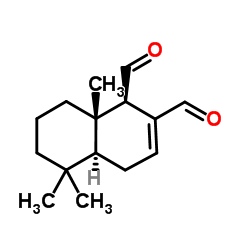Naturally occurring compounds affect glutamatergic neurotransmission in rat brain.
Lucia Helena Martini, Fernanda Jung, Felix Antunes Soares, Liane Nanci Rotta, Deusa Aparecida Vendite, Marcos Emilio dos Santos Frizzo, Rosendo A Yunes, João Batista Calixto, Susana Wofchuk, Diogo O Souza
Index: Neurochem. Res. 32(11) , 1950-6, (2007)
Full Text: HTML
Abstract
Natural products, including those derived from plants, have largely contributed to the development of therapeutic drugs. Glutamate is the main excitatory neurotransmitter in the central nervous system and it is also considered a nociceptive neurotransmitter, by acting on peripheral nervous system. For this reason, in this study we investigated the effects of the hydroalcoholic extracts from Drymis winteri (polygodial and drimanial), Phyllanthus (rutin and quercetine), Jathopha elliptica (jatrophone), Hedyosmum brasiliense (13HDS), Ocotea suaveolens (Tormentic acid), Protium kleinii (alphabeta-amyrin), Citrus paradise (naringin), soybean (genistein) and Crataeva nurvala (lupeol), described as having antinociceptive effects, on glutamatergic transmission parameters, such as [(3)H]glutamate binding, [(3)H]glutamate uptake by synaptic vesicles and astrocyte cultures, and synaptosomal [(3)H]glutamate release. All the glutamatergic parameters were affected by one or more of these compounds. Specifically, drimanial and polygodial presented more broad and profound effects, requiring more investigation on their mechanisms. The putative central side effects of these compounds, via the glutamatergic system, are discussed.
Related Compounds
| Structure | Name/CAS No. | Molecular Formula | Articles |
|---|---|---|---|
 |
(-)-Polygodial
CAS:6754-20-7 |
C15H22O2 |
|
Screening for negative effects of candidate ascidian antifou...
2013-01-01 [Biofouling 29(1) , 29-37, (2013)] |
|
Preventing ascidian fouling in aquaculture: screening select...
2012-01-01 [Biofouling 28(1) , 39-49, (2012)] |
|
Inhibition of the mitochondrial ATP synthesis by polygodial,...
2005-07-01 [Biochem. Pharmacol. 70(1) , 82-9, (2005)] |
|
Antibacterial activity of polygodial.
2005-12-01 [Phytother Res. 19(12) , 1013-7, (2005)] |
|
Synergism of polygodial and trans-cinnamic acid on inhibitio...
2003-10-01 [J. Chem. Ecol. 29(10) , 2253-62, (2003)] |